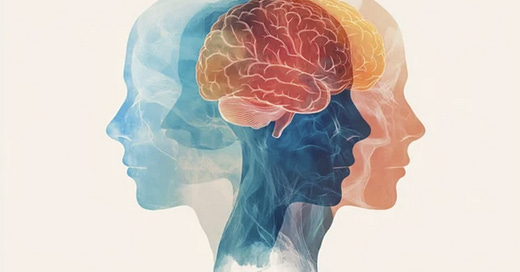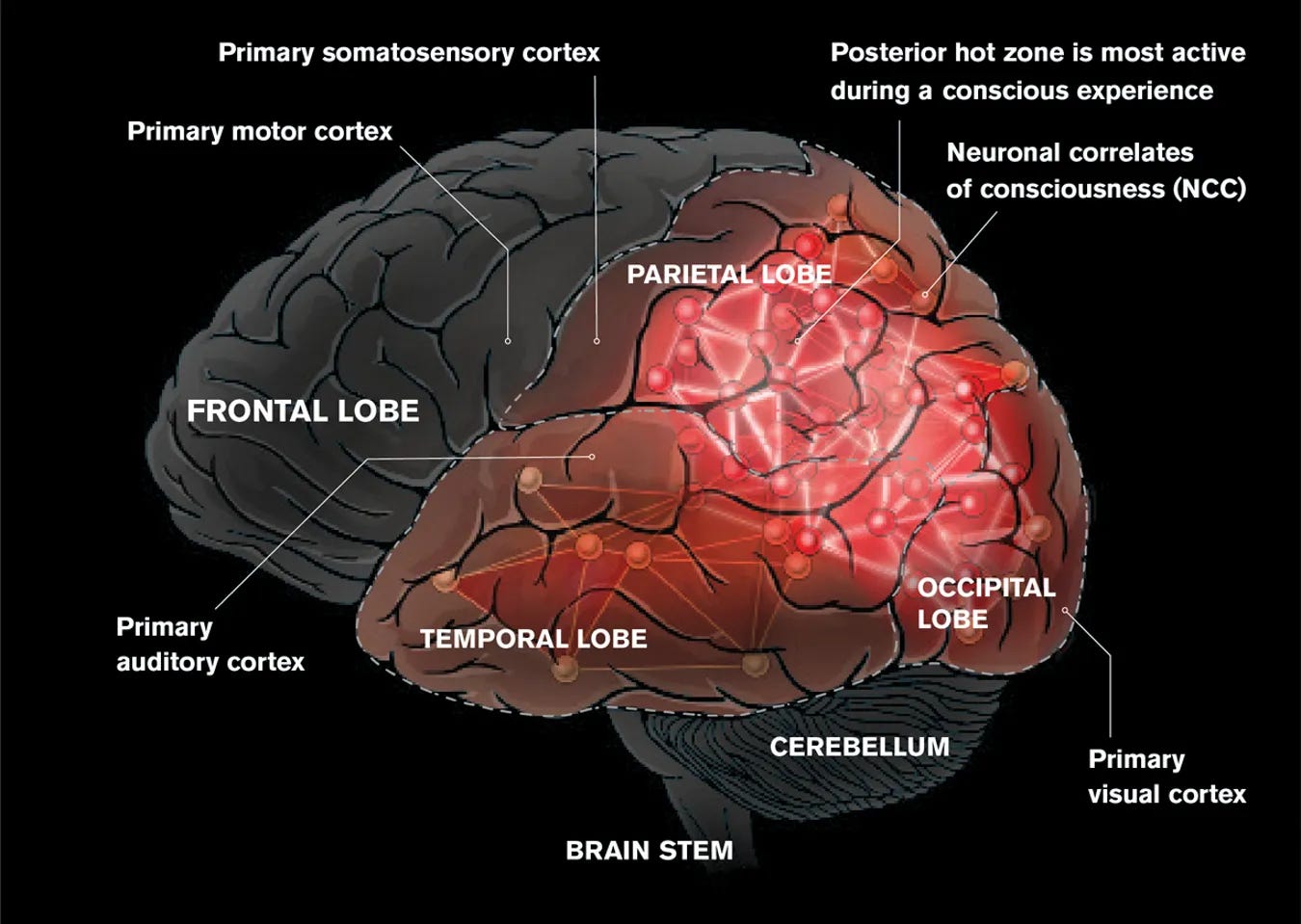"A human being is a part of the whole, called by us "Universe," a part limited in time and space. He experiences himself, his thoughts and feelings as something separate from the rest, a kind of optical delusion of his consciousness. "- Albert Einstein.
I first pondered the question of consciousness when I heard Swami Sarvapriyananda’s lecture at the Indian Institute of Science (IISc). His lecture on the nature of consciousness left me perplexed, not only by the depth of the subject matter but also by the knowledge that humanity has struggled with this puzzle for centuries. Ancient sages in India had dedicated their lives to studying consciousness; countless philosophical and spiritual texts have been written about this profound question. Yet even modern science remains in its infancy when unraveling this profound question of consciousness.
In this brief post, I'll explore consciousness through the lens of modern science, focusing on emerging insights from neuroscience and technology. More ambitiously, I'll share a naive yet intriguing attempt to approach this age-old question using brain-computer interface (BCI) systems. Can cutting-edge tools like BCIs—which bridge neural activity with computational devices—shed light on the elusive nature of awareness, selfhood, or subjective experience? Let's dive in.
What is consciousness?
Giving a single definition of consciousness will not be correct as we still have no universally agreed-upon definition. At its core, consciousness is the raw, subjective 'feel' of existence—what philosopher Thomas Nagel famously called the 'what-it-is-like' quality of being (Nagel, 1974). For Nagel, a bat's echolocation experience isn't just neural firings; it's the vivid, private reality of being that bat, a perspective science can't replicate. Decades later, his insight still sparks diverse debates: theories like integrated information theory (Tononi et al, 2016) propose consciousness arises from complex brain networks, while panpsychists argue even particles might hold flickers of awareness. Yet none fully bridge the gap between measurable biology and the inner 'view from within.
Contemporary neuroscience delineates brain activity associated with consciousness, yet, as Nagel cautioned, explaining why specific processes are experienced—whether by humans, bats, or AI—remains the pinnacle of scientific inquiry. Consciousness, then, endures as both a biological puzzle and a reminder: reality isn't just what we observe but what we experience.
The complex problem of consciousness
The study of consciousness presents an intriguing paradox in our attempt to comprehend the mind. The "easy problems of consciousness" include understanding the functional components of cognition, such as how human brains integrate sensory data, retain memories, and coordinate movement. Scientists call things "easy" not because they are simple but because they adhere to the standard scientific method of finding physical mechanisms that accomplish certain activities. We can track visual processing via brain pathways, identify language centers, and model decision-making circuits without addressing the underlying riddle.
The "hard problems of consciousness," as philosopher David Chalmers eloquently put it, confronts us with consciousness itself—the raw sensation of being alive and aware. It questions why brain-firing patterns, no matter how complex, should produce any subjective experience. When you see a sunset, scientists can describe how light waves strike your retina and cause cascading brain responses, but why does this physical process result in the vivid, intimate feeling of golden-orange hues filling your awareness? This explanatory gap between bodily processes and felt experience defies our current scientific frameworks, implying that we may require revolutionary new concepts—perhaps even fundamental assumptions about matter, information, and reality—to bridge the chasm between brain and mind.
Neural Decoding of Conscious States
The first step towards decoding the complex problem of consciousness might involve identifying the neural signatures that underlie subjective experiences. Researchers are particularly interested in how different neuronal firing patterns, synchronization across brain regions, and dynamic network connectivity relate to various states of awareness (Storm, Johan F., et al 2024). The challenge lies in the inherent complexity and individual variability of brain networks. However, recent research has begun to shed light on this issue by combining high-resolution neural recording techniques with advanced computational models.
A promising line of inquiry involves the study of "neural correlates of consciousness" (NCC) (Crick and Koch, 2003). The NCC is the minimal neural event sufficient for a specific conscious experience. Using BCIs, scientists have begun to monitor these neural patterns in real-time. For example, by correlating EEG (electroencephalography) signals and Blood Oxygenation Level Dependent (BOLD) signal patterns with reports of visual perception, researchers have been able to identify transient oscillatory patterns that seem to signify the transition from unconscious processing to conscious awareness, like attention. These findings not only support theoretical models of consciousness but also open up potential clinical applications, such as assessing the level of awareness in patients with disorders of consciousness.
However, current methods of decoding consciousness using fMRI and EEG often rely on fixed assumptions about which brain regions to monitor and require patients to actively follow commands, which can oversimplify consciousness as simply "present" or "absent." Thus, we might miss the subtle signs of awareness, especially in brain-injured patients whose neural responses can be disrupted. Neural decoding offers a promising alternative by analyzing overall patterns of brain activity to reconstruct what a patient might be experiencing—whether that's a basic sound or a complex idea—without depending on predefined brain areas or strict task performance (Fischer et al., 2025). Although challenges like the need for large amounts of data and privacy issues still exist, this approach provides a more flexible and detailed way to uncover hidden levels of consciousness.
The era of BCI and consciousness
The potential of neural decoding to uncover hidden consciousness—freeing assessments from rigid brain maps or patient effort—echoes breakthroughs seen in invasive brain-computer interfaces (BCIs). BCI systems, by decoding the neural signatures of awareness, give us the tools to uncover not just whether someone is conscious, but how they experience their world. Research with implanted BCIs, for instance, has shown that individuals with severe motor limitations can share their thoughts by choosing responses via computer systems (Hochberg et al., 2012), revealing how technology can tap directly into conscious states. Similarly, neural decoding methods, like those reconstructing speech or concepts from brain activity (Tang et al., 2023), highlight how awareness exists on a spectrum, not just as a simple "on" or "off." Both approaches underscore a critical shift: moving beyond essential detection to understanding how patients experience their world. By blending neural decoding’s ability to detect subtle awareness with BCIs’ capacity for interactive communication, future tools could empower patients to demonstrate consciousness and actively engage in their care—transforming rehabilitation and offering new ways to bridge inner thoughts with outward expression.
BCIs and the Detection of Consciousness in Non-Responsive Patients
A central focus in BCI research concerning consciousness is the evaluation of patients with disorders of consciousness (DoC), particularly those in minimally conscious states (MCS) or unresponsive wakefulness syndrome (UWS), also known as a vegetative state. Patients in these conditions lack awareness, complicating diagnosis and treatment. BCI technologies based on EEG and fMRI systems have become essential for identifying "covert consciousness," a condition where patients maintain awareness yet are unable to respond.
Few of the recent studies show good promise of using brain-computer interfaces (BCIs) for detecting consciousness in unresponsive patients. Spataro et al. (2022) had used a vibrotactile P300-based BCI system to identify command-following in patients who otherwise could not communicate. Pokorny et al. (2013) investigated EEG-based auditory P300 paradigms, demonstrating that single-switch BCIs may be a communication tool for minimally conscious patients by circumventing motor impairments. For a more comprehensive overview of EEG and fMRI-based BCI techniques used to evaluate awareness in patients with severe brain injuries, including key challenges like false negatives in detecting covert consciousness read Annen et al. (2020)
Also, hybrid BCI approaches integrating various neural response modalities have been proposed to enhance detection accuracy. Huang et al. (2021) created a hybrid asynchronous brain-computer interface system that integrates P300 and steady-state visual-evoked potentials (SSVEP), facilitating real-time yes/no communication with patients in a state of disorders of consciousness (DOC). Interestingly, the Coma Recovery Scale-Revised scores of the patients also improved after the experiment. In another complementary study, Xie et al. (2018) used a gaze-independent audiovisual BCI, employing event-related potentials (P300, N400) to evaluate the level of awareness in patients with disorders of consciousness. These studies show how BCI-based techniques are becoming more sophisticated in assessing patients who would be challenging to diagnose otherwise.
Challenges and Future Directions
Despite significant progress, some fundamental challenges with BCIs for decoding consciousness still exist. One considerable drawback is the possibility of false negatives—instances where a BCI overlooks consciousness in a patient who is, in fact, aware. Studies such as Galiotta et al. (2022) highlight the variability in EEG signal strength and patient involvement as issues that must be handled to increase practical relevance. Another issue is finding the exact neural correlates of consciousness (NCCs) that can be studied with BCI. Many current studies have simply differentiated between the conscious and unconscious states instead of finding the fundamental neural processes that make awareness possible.
However, the ongoing integration of multimodal BCIs, such as fMRI-EEG hybrids enhancing the sensitivity and specificity of consciousness detection, is a promising avenue. Advancements in tailored machine learning algorithms could also lower individual variation in BCI response readings, enabling more substantial clinical evaluation uses. For enhanced patient-specific evaluations, particularly in completely locked-in syndrome (CLIS) patients, Adama & Bogdan (2022) suggest specialized clustering algorithms to precisely identify individual consciousness transitions.
Conclusion
Decoding consciousness is not easy. Brain-computer interfaces and other recent advancements in neuroscience have transformed how we understand and evaluate consciousness. These advances have had many uses, from diagnosing covert awareness in the clinic to more theoretical research into neural decoding and non-cortical consciousness (NCCs). Many recent studies focus on using BCIs to find out if patients who aren't responding are aware of what's going on. Still, new research directions are opening up, especially in improving functional connectivity analysis and machine learning-based decoding. Despite current challenges, the track of BCI research shows that as detection methods get more precise and theoretically grounded, they will keep giving crucial insights into one of the greatest scientific mysteries—the nature of human consciousness.
🔦Contributor Spotlight🔦
We’re excited to spotlight Ankan Biswas, a final-year graduate student at the Centre for Neuroscience, Indian Institute of Science. Ankan’s research explores the fascinating role of brain oscillations in meditation and color processing—an intersection of cognition, perception, and consciousness.
His work reflects a deep curiosity for the rhythms of the brain and how they shape our experience of the world. Whether decoding altered states or unraveling sensory processing, Ankan is contributing to a more nuanced understanding of the human mind.
🌟 Neurotech Pulse Special Edition: Call for Contributions!
Calling all researchers and writers! Want to showcase your work in our upcoming Neurotech Insights edition? Reach over 5,000+ neurotech enthusiasts by sharing your innovative research. Submit your details and work to saman.nawaz@nexstem.ai
❤️ Join us on Discord.
Thanks for reading Neurotech Pulse! Subscribe for free to receive new posts.







